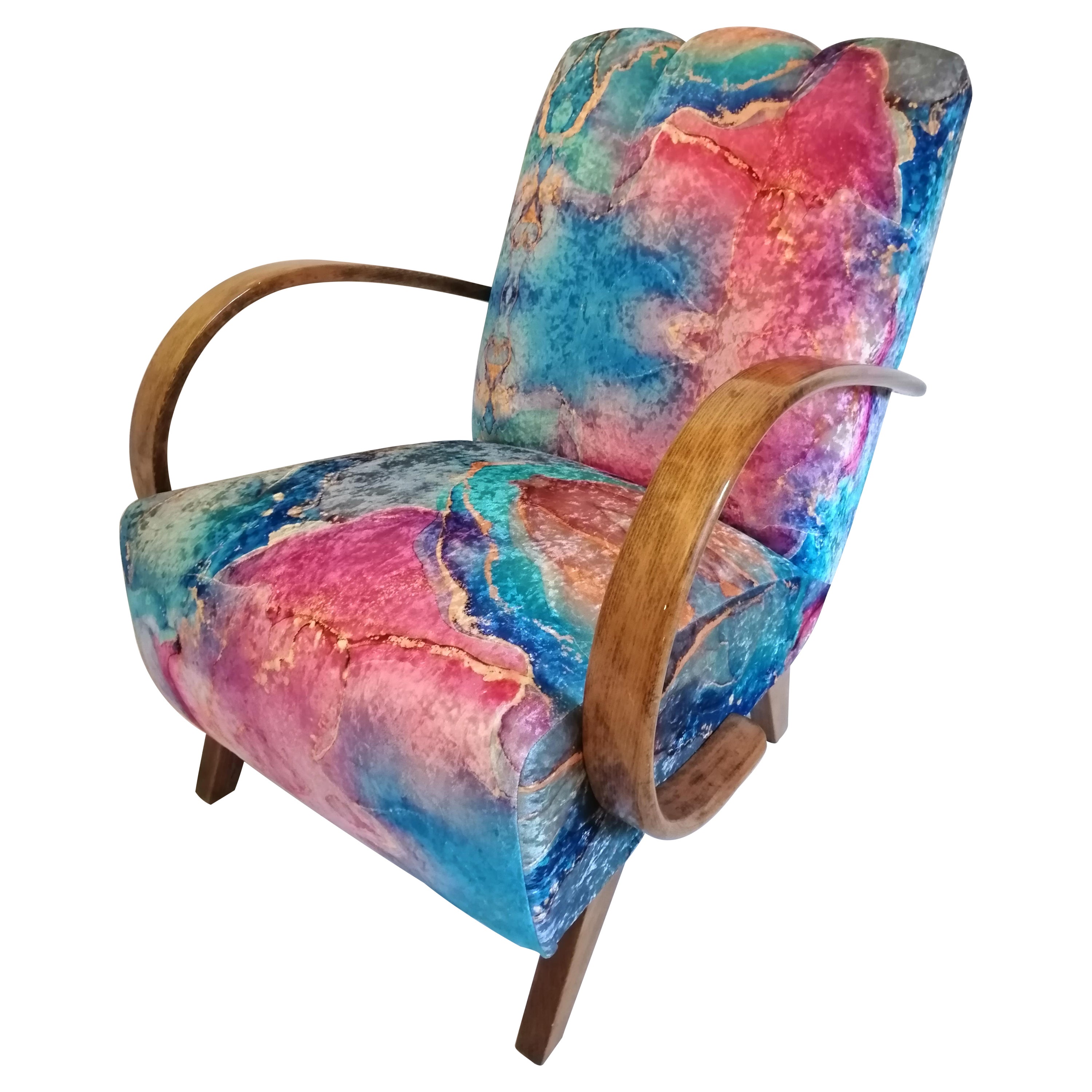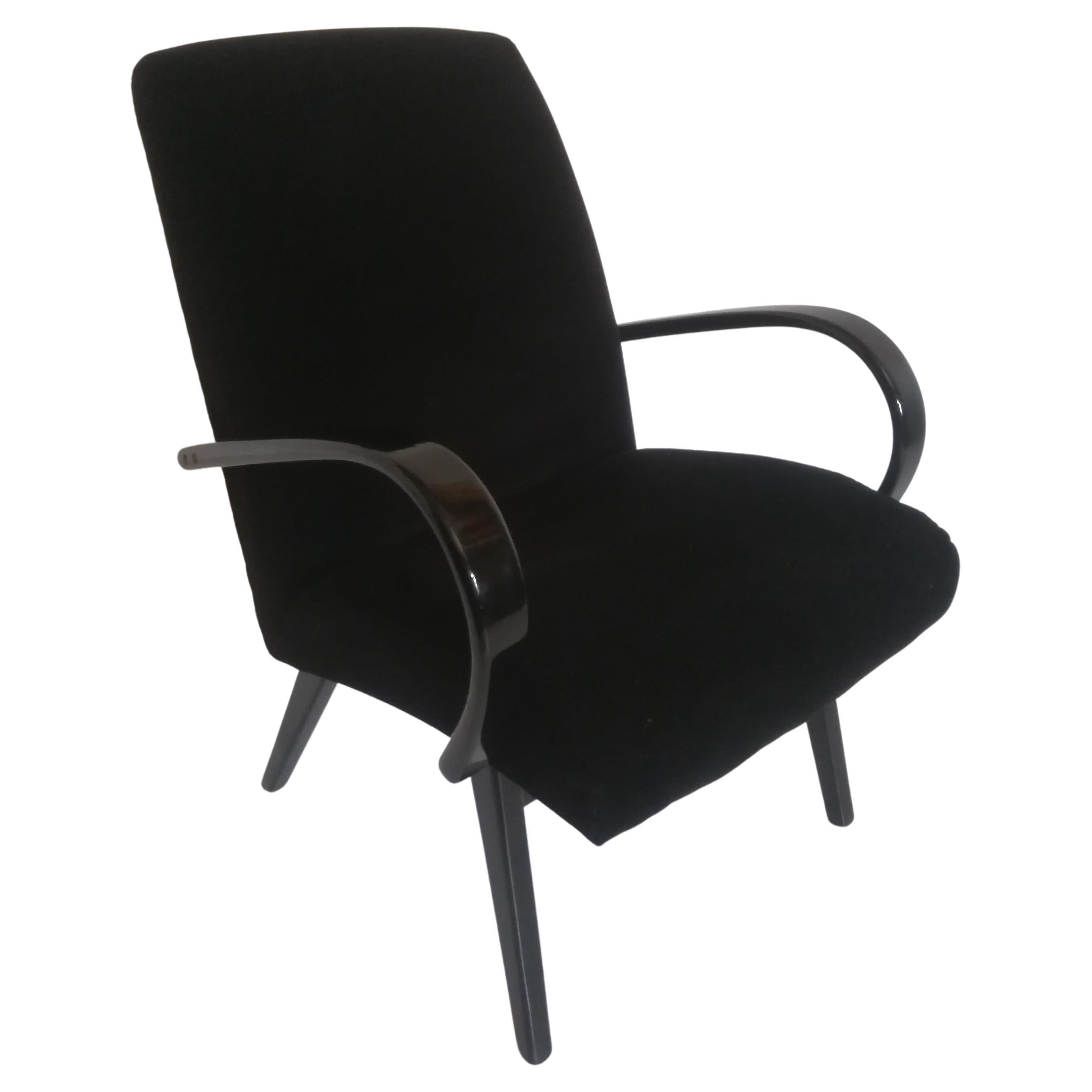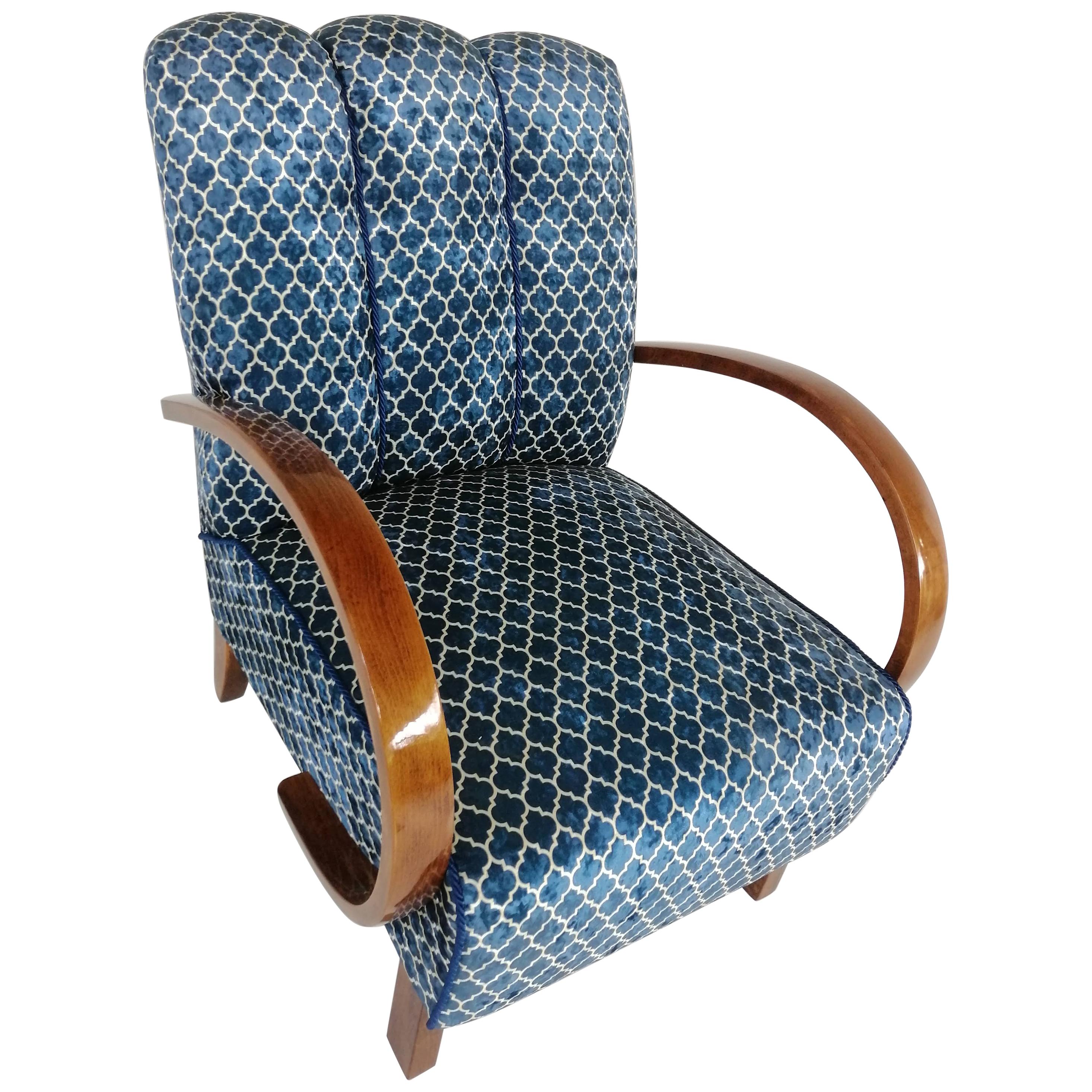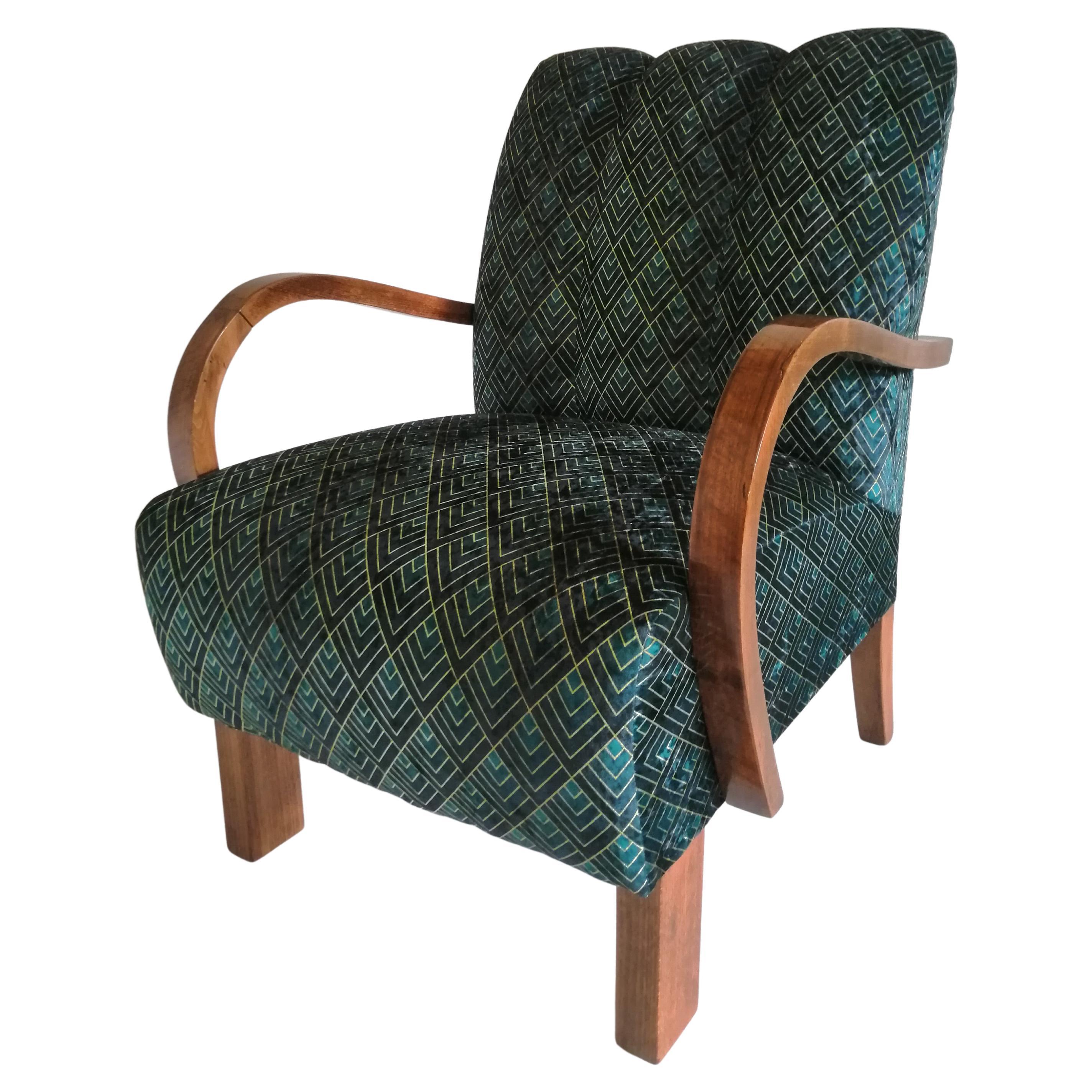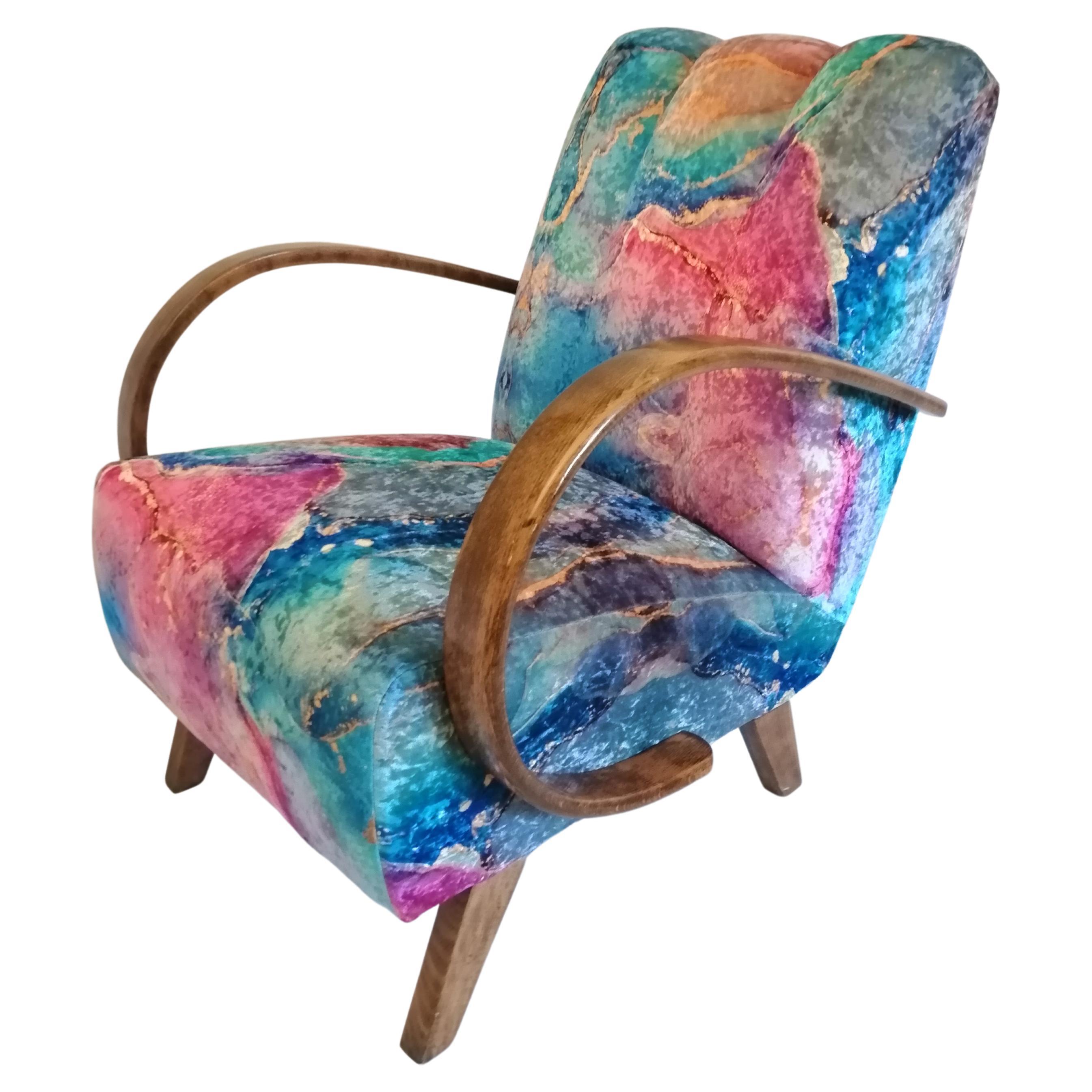Art Deco J. Halabala Set 2 chairs table with sofa
About the Item
- Creator:Jindrich Halabala (Artist)
- Dimensions:Height: 39.38 in (100 cm)Width: 39.38 in (100 cm)Depth: 39.38 in (100 cm)Seat Height: 39.38 in (100 cm)
- Sold As:Set of 4
- Style:Art Deco (In the Style Of)
- Materials and Techniques:
- Place of Origin:
- Period:
- Date of Manufacture:1940
- Condition:Wear consistent with age and use. Possible signs of use under the coat of varnish.
- Seller Location:Kraków, PL
- Reference Number:1stDibs: LU4552138774532
Jindrich Halabala
Thanks to design lovers’ enthusiasm for Art Deco and mid-century modern furniture, and the increasingly competitive market for pieces by more famous creators, 20th-century Czech designers are making their way back onto the international stage. Foremost among these talents is Jindrich Halabala.
Halabala was a cabinetmaker’s son whose training was almost wholly focused on woodwork, first at a state-run vocational school for woodworking in Valašské Meziříčí and later at UP Závody in Brno, where he ultimately became chief designer. His curvaceous bentwood H chairs, such as the H269 and H237, and stylized ottomans have become classics, while his 1930s and 1940s sofas, tables and storage cabinets, with their sweeping curves, stylized geometry and dark, richly grained wood, embody the best of Art Deco furniture design, a style that was brought to worldwide attention at an exhibition in Paris in 1925.
Some see Halabala's work as the segue between early 1900s Czech Cubism and the modern style that dominated the mid-century.
Find a collection of vintage Jindrich Halabala furniture today on 1stDibs.
- ShippingRetrieving quote...Ships From: Kraków, Poland
- Return PolicyA return for this item may be initiated within 3 days of delivery.
- Art Deco J. Halabala ArmchairLocated in Kraków, MałopolskaArt Deco armchair from 1940, Czech Republic. Designed by a famous Czech designer Jindrich Halabala, (a Czech designer ranked among the most outstanding creators of the modern period...Category
Vintage 1930s Czech Art Deco Armchairs
MaterialsWalnut
- Art Deco J. Halabala ArmchairLocated in Kraków, MałopolskaArt Deco armchair from 1940, Czech Republic. Designed by a famous Czech designer Jindrich Halabala, (a Czech designer ranked among the most outstanding creators of the modern period...Category
Vintage 1950s Czech Art Deco Armchairs
MaterialsWalnut
- Art Deco J. Halabala Armchair .Located in Kraków, MałopolskaArt Deco armchair from 1940, Czech Republic. Designed by a famous Czech designer Jindrich Halabala, (a Czech designer ranked among the most outstanding creators of the modern period...Category
Vintage 1930s Czech Art Deco Armchairs
MaterialsWalnut
- Art Deco J. Halabala ArmchairLocated in Kraków, MałopolskaArt Deco armchair from 1940, Czech Republic. Designed by a famous Czech designer Jindrich Halabala, (a Czech designer ranked among the most outstanding creators of the modern period...Category
Vintage 1930s Czech Art Deco Armchairs
MaterialsWalnut
- Art Deco J. Halabala ArmchairLocated in Kraków, MałopolskaArt Deco armchair from 1940, Czech Republic. Designed by a famous Czech designer Jindrich Halabala, (a Czech designer ranked among the most outstanding creators of the modern period...Category
Vintage 1930s Czech Art Deco Armchairs
MaterialsWalnut
- Art Deco J. Halabala Armchair .Located in Kraków, MałopolskaArt Deco armchair from 1940, Czech Republic. Designed by a famous Czech designer Jindrich Halabala, (a Czech designer ranked among the most outstanding creators of the modern period...Category
Vintage 1930s Czech Art Deco Armchairs
MaterialsWalnut
- Art Deco Lounge Chair by Jindrich HalabalaBy Jindrich HalabalaLocated in Vienna, ATBeech bentwood frame upholstered seat and back rest. Designed in 1930s by Jindrich Halabala. Excelent restored, another upholstery on request possible. Set of two.Category
Vintage 1930s Czech Art Deco Armchairs
MaterialsBeech, Bentwood
- Art Deco Lounge Chairs by Jindrich HalabalaBy Jindrich HalabalaLocated in Vienna, ATBeech bentwood frame upholstered seat and back rest. Designed in 1930s by Jindrich Halabala. Excelent restored, another upholstery on request possible. Set of two.Category
Vintage 1930s Czech Art Deco Armchairs
MaterialsBeech, Bentwood
- Desk Chair Style: Art Deco, France, 1920Located in Ciudad Autónoma Buenos Aires, CArt Deco desk chair Country: France If you are looking for a desk chair to match your desk, we have what you need. We have specialized in the sale of Art Deco and Art Nouveau and Vintage styles since 1982. If you have any questions we are at your disposal. Pushing the button that reads 'View All From Seller'. And you can see more objects to the style for sale. Why are there so many antiques in Argentina? In the 1880 – 1940 there was a grate wave of immigration encouraged by the periods of war that were taking place. 1st World War took place between 1914 and 1918 2nd World War took place between 1939 and 1945 The immigrants options were New York or Buenos Aires. Tickets were cheap and in Buenos Aires they were welcomed with open arms, as it was a country where everything was still to be done. Argentina was the country of new opportunities, labour was needed and religious freedom was assured, in many cases the of the family travel first until they were settled and then the rest of the family members join them. In the immigrant museum “Ellis Island Immigrant Building” in New York you can se the promotional posters of the boats that would take them to a new life. Between the years 1895 and 1896, Argentina had the highest DGP (gross domestic product) per capita in the world according to the Maddison Historical Statistics index, this situation arose due to the large amount of food being exported to European countries, which were at war. The Argentinean ships left the port of Buenos Aires with food, but they returned with furniture, clothes and construction elements, (it´s common to see this the old buildings of the historic neighbourhood of San Telmo, the beams with the inscription “Made in England)”, as well as many markets that were built in Buenos Aires, such us the San Telmo Market, whose structure was brought by ship and afterwards assembled in 900 Defensa Street. With the great influence of European immigrants living in the country, the children of the upper classes travelled to study in France, resulting in the inauguration of “La Maison Argentinienne”, on 27th of June 1928, in the international city of Paris, which hosted many Argentinians that were studying in Frace. It´s the fourth house to be built after France, Canada and Belgium, being the first Spanish-speaking one. Still in place today (17 Bd Jourdan, 75014, Paris, France). Many of the children of these wealthy families who attended international art exhibitions, museums and art courses abroad, took a keen interest in the European style. This is why Buenos Aires was at the time referred as “The Paris of South America”. Between the years 1890 and 1920 more than a hundred Palaces were built on Alvear Avenue the most exclusive avenue in Buenos Aires. Today some of these palaces have been transformed into museums, hotels and embassies. In the year 1936, the Kavanagh building was inaugurated, it was the tallest reinforced concrete building in South America. During 1994 the American Society of Civil Engineers distinguished it as an “international engineering milestone”, and it´s now considered a World Heritage of Modern Architecture. At the time was common to hire foreign architects such as Le Corbusier, who visited Buenos Aires/Argentina in 1929 and in 1948 he drew up the blueprints for a house built in La Plata City (which was declared a World Heritage Site). In 1947, the Hungarian architect Marcelo Breuer designed “Parador Ariston” in the seaside city of Mar del Plata. After an Argentinean student at Harvard University convinced him to come to Argentina. He worked on an urban development project in the Casa Amarilla, area of La Boca. The Ukrainian architect, Vladimiro Acosta, arrives in Argentina in 1928 and worked as an architect until que moved to Brazil. Antonio Bonet, a Spanish architect who worked with Le Corbusier in Paris, arrives in Argentina in 1937, where he carried out several architectural works and in 1938 designs the well-known BFK...Category
Vintage 1920s French Art Deco Office Chairs and Desk Chairs
MaterialsWood
- Desk Chair Style: Art Deco, France, 1930Located in Ciudad Autónoma Buenos Aires, CArt Deco desk chair Wood Year: 1930 Country: France If you are looking for a desk chair to match your desk, we have what you need. We have specialized in the sale of Art Deco and Art Nouveau and Vintage styles since 1982. Pushing the button that reads 'View All From Seller'. And you can see more objects to the style for sale. Why are there so many antiques in Argentina? In the 1880 – 1940 there was a grate wave of immigration encouraged by the periods of war that were taking place. 1st World War took place between 1914 and 1918 2nd World War took place between 1939 and 1945 The immigrants options were New York or Buenos Aires. Tickets were cheap and in Buenos Aires they were welcomed with open arms, as it was a country where everything was still to be done. Argentina was the country of new opportunities, labour was needed and religious freedom was assured, in many cases the of the family travel first until they were settled and then the rest of the family members join them. In the immigrant museum “Ellis Island Immigrant Building” in New York you can se the promotional posters of the boats that would take them to a new life. Between the years 1895 and 1896, Argentina had the highest DGP (gross domestic product) per capita in the world according to the Maddison Historical Statistics index, this situation arose due to the large amount of food being exported to European countries, which were at war. The Argentinean ships left the port of Buenos Aires with food, but they returned with furniture, clothes and construction elements, (it´s common to see this the old buildings of the historic neighbourhood of San Telmo, the beams with the inscription “Made in England)”, as well as many markets that were built in Buenos Aires, such us the San Telmo Market, whose structure was brought by ship and afterwards assembled in 900 Defensa Street. With the great influence of European immigrants living in the country, the children of the upper classes travelled to study in France, resulting in the inauguration of “La Maison Argentinienne”, on 27th of June 1928, in the international city of Paris, which hosted many Argentinians that were studying in Frace. It´s the fourth house to be built after France, Canada and Belgium, being the first Spanish-speaking one. Still in place today (17 Bd Jourdan, 75014, Paris, France). Many of the children of these wealthy families who attended international art exhibitions, museums and art courses abroad, took a keen interest in the European style. This is why Buenos Aires was at the time referred as “The Paris of South America”. Between the years 1890 and 1920 more than a hundred Palaces were built on Alvear Avenue the most exclusive avenue in Buenos Aires. Today some of these palaces have been transformed into museums, hotels and embassies. In the year 1936, the Kavanagh building was inaugurated, it was the tallest reinforced concrete building in South America. During 1994 the American Society of Civil Engineers distinguished it as an “international engineering milestone”, and it´s now considered a World Heritage of Modern Architecture. At the time was common to hire foreign architects such as Le Corbusier, who visited Buenos Aires/Argentina in 1929 and in 1948 he drew up the blueprints for a house built in La Plata City (which was declared a World Heritage Site). In 1947, the Hungarian architect Marcelo Breuer designed “Parador Ariston” in the seaside city of Mar del Plata. After an Argentinean student at Harvard University convinced him to come to Argentina. He worked on an urban development project in the Casa Amarilla, area of La Boca. The Ukrainian architect, Vladimiro Acosta, arrives in Argentina in 1928 and worked as an architect until que moved to Brazil. Antonio Bonet, a Spanish architect who worked with Le Corbusier in Paris, arrives in Argentina in 1937, where he carried out several architectural works and in 1938 designs the well-known BFK chair...Category
Vintage 1930s French Art Deco Office Chairs and Desk Chairs
MaterialsWood
- Fine French Art Deco Mahogany Arm ChairLocated in Long Island City, NYA fine French 1930's mahogany armchair in the manner of Adnet.Category
Vintage 1930s French Art Deco Office Chairs and Desk Chairs
MaterialsMahogany
- Art Deco Hungarian Office Chair in WalnutLocated in Houston, TXArt Deco Hungarian office chair in walnut Office chair is done in a fine walnut wood, newly re-upholstered in brown leather. It has 2 armrests and elevated by the 4 elongated wooden...Category
Vintage 1930s Hungarian Art Deco Armchairs
MaterialsWalnut
